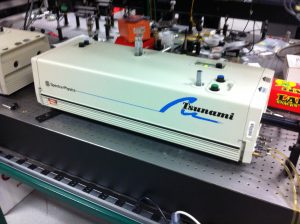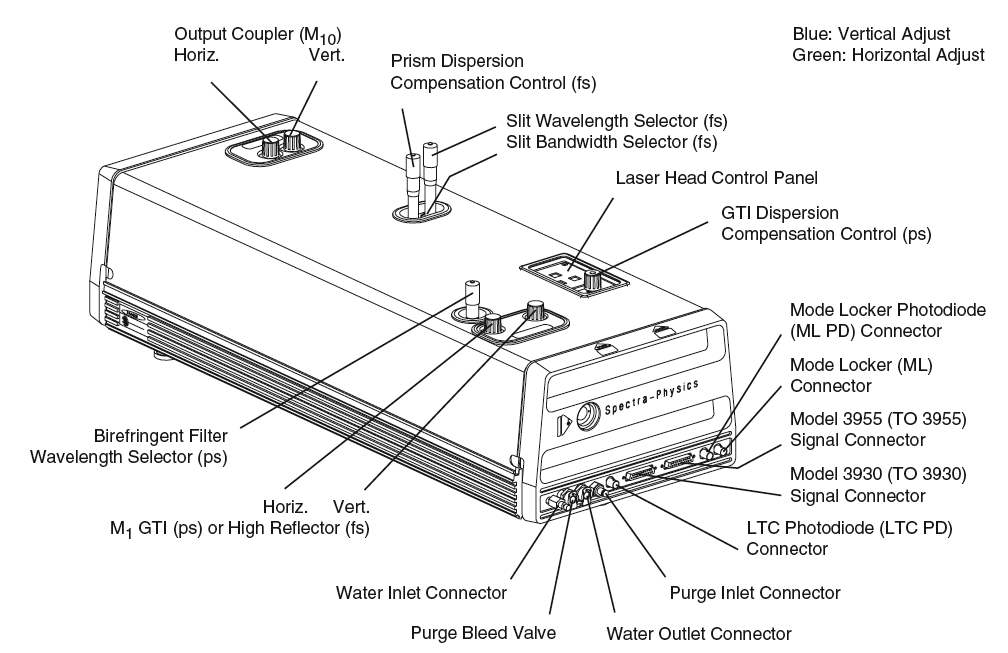Jump to:
System Description | Hazards | Approved Users | Documentation | Controls | Recommended Practices | Maintenance | Emergency Procedures | Revision History
System Description
The Tsunami is located in Room 2135 of the Kim Engineering Building, on the optics bench farthest from the door. It is part of a system composed of the Verdi (the pump laser for the Tsunami), the Tsunami and the Opal (an optically pumped parametric oscillator, which is driven by the Tsunami).
- Manufacturer: Spectra-Physics (Newport Corporation)
- Product Name(s): Tsunami (Note: system also includes Verdi Pump Laser, manufactured by Coherent)
- Model: 3960-L1S
- Serial Number: 1370G
- UMD Property Tag: 118171
- Manufactured Date: 12/1995
- Location: KEB 2130 (see map above)
- Laser Type: Ultrafast mode-locked Ti-Sapphire Laser
- Laser Classification: Class IV
- Wavelength (Center): 800 nm (pump laser operates at 532 nm)
- Repetition Rate: 80 MHz
- Pulse Duration: 100-150 fs
- Average Power (energy): 1.7-2.0 W (21-25 nJ)
- Beam Diameter: Approx. Gaussian, with 1/e2 width of 2 mm
- Beam Divergence: < 1 mrad
- Polarization: vertical, with polarization extinction ratio 500:1
Hazards
- Eye/vision: Visible and/or invisible laser radiation. Avoid eye exposure to direct or scattered radiation. Direct eye contact with the output beam from the laser will cause serious damage and possible blindness. Appropriate laser safety eyewear must be worn by all personnel present in laboratory while laser is operating
- Electrical: Removing the electrical power supply cover will expose the user to potentially lethal electrical hazards.
- Skin/burn hazard. Even when not focused, the beam emerging from the laser can cause serious burns or damage wherever the laser is absorbed on stationary surfaces, including skin or clothing.
Approved Users
All users must have completed the mandatory Laser Safety training: https://des.umd.edu/risk_comm/edu/training.cfm Further, all users must receive proper safety training from the PI, other authorized users, or Coherent service technician before operating the Libra. The following are currently authorized users:
- Mehdi Jadidi
- Kyowon Kim
- Shanshan Li
- Ryan Suess
- Jeremiah J. Wathen
When the laser is in use, a sign should be placed on the door, advising all visitors and laboratory personnel of the wavelengths in use. All personnel entering the laboratory (whether or not they are using the laser) must wear the appropriate laser safety eyewear. Under normal operation, the 532 nm pump lasers are enclosed inside of the system. Under this condition, it is permissible for users to select laser glasses/goggles that block the 800 nm output wavelength.
Visitors may be permitted in the lab while the Tsunami is operating, but only under the following conditions:
- The visitor has donned the proper eye protection (> OD 7 @ 800 nm).
- The visitor has been briefed on the paths of all beams in the lab.
- The beam-path is enclosed to the extent possible, with all beams terminated properly (i.e., in folded metal beam dumps or razor-stack beam dumps).
- No adjustments are made to the beam-path while the visitor is present.
- The laser’s cavity must be enclosed while the visitor is present.
Documentation
A bound, hardcopy version of the Tsunami’s manual can be found in Kim 2135, in the wall cabinets behind the laser.
NOTE: NEED TO PROVIDE LINK TO SOFT-COPY PDF
Controls
The Tsunami is capable of generating coherent, continuous-wave and pulsed visible and invisible radiation with an average power of 2 Watts. Direct and scattered light from the laser is capable of causing permanent damage to the eye. Additionally, the beam represents a fire hazard if it illuminates combustible material. In its current configuration, the Tsunami’s normal operating wavelength is approximately 800 nm, which is beyond the visible spectrum of the human eye. However, the beam typically carries enough visible radiation that it appears red on a diffuse reflector. While this property is useful for routing and aligning the beam, keep in mind that the perceived brightness of the beam does not correspond to the actual intensity since most of the beam’s intensity is invisible. To ensure the safety of the user and coworkers in the laboratory, the following precautions should be followed during operation of the laser.
- During alignment of the beam, wear suitable eye protection (> OD5 @ 800 nm).
- Inform all personnel having access to the lab prior to aligning/re-routing the beam.
- During normal operation of the laser without an enclosure (i.e., when the laser is not being aligned, but is being used), eye protection of >OD7 @ 800 nm is recommended.
- Enclose the beam path when practical.
- When routing the beam, use an optical attenuator to reduce the beam power prior to adjusting mirrors. The high power of the beam necessitates use of a reflective ND filter.
- Terminate all beams with proper beam dumps (i.e., folded metal beam stops or stacked-razor beam stops).
- Maintain the beam height at the default height if possible. If it is necessary to adjust the beam height, ensure all personnel with access to the lab have been briefed on the beam height and beam path.
- Keep the beam path free of combustible material.
- Avoid exposure of the skin and eyes to direct or scattered laser light.
- Turn off the pump laser or close the output shutter when the laser is not in use.
- To reduce the possibility of eye damage, maintain a high ambient light level in the laser operation area during normal operation.
- Unless actively aligning the laser, maintain the cavity cover installed at all times.
- Avoid wearing reflective objects such as jewelry or watches while in the laser operation area.
The recommended eyewear (>OD7 @ 800 nm for normal operation, >OD5 @ 800 nm for alignment) can be found in the goggle locker in Kim 2135.
The Tsunami incorporates a cavity interlock, which prevents the laser from operating when the cavity enclosure cover is removed. Only override this interlock when it is necessary to align the Tsunami’s cavity. Minimize the pump power supplied to the Tsunami’s cavity when the cavity interlock is in override.
Recommended Practices
Standard day-to-day operating procedures for the Tsunami can be found in Chapter 7 of the Tsunami’s manual. Key points and additional guidance follow here.
System Startup and Normal Operation
- Verify the Model 3955 electronics module is on. The Model 3955 electronics module should remain on at all times to maintain thermal stability of the Tsunami’s acousto-optic modulator.
- Ensure the chilled water system is operating prior to admitting the pump beam to the Tsunami’s cavity. Verify the chiller is operating with a temperature setpoint of 18°C.
- Block the output of the Tsunami with a power meter or suitable beam block. Switch on the pump laser (the Verdi) and open the pump shutter. Typically, the Verdi should output > 9.6 Watts in order to obtain >1.8 Watts output from the Tsunami. Allow a minimum of 10 minutes after switching on the pump laser before optimizing the Tsunami’s output power. The pump laser (the Verdi) takes time to reach thermal equilibrium.
- Optimize power output from the Tsunami and start mode-locking
Mode Locking procedure:
- Project the Tsunami’s output onto a suitablel power meter.
- While monitoring the output power on the power meter and the PHOTODIODE LED indication on the 3955 electronics module, adjust mirrors M10 and M1 for maximum output power and note the power level. You should easily be able to obtain > 1.8 Watts out of the Tsunami (@ 810 nm). You can often increase output power a little more by “walking the beam.” See the “Optimizing Laser Output” procedure in Chapter 7 of the Tsunami’s manual. At least 1.85 Watts of power from the Tsunami is required to drive the Opal. Only an experienced operator of the Tsunami should attempt to adjust cavity mirrors other than M1 and M10. Severe misalignment can occur. If you are new to the Tsunami and cannot obtain sufficient output power by simple adjustments of M1 and M10, obtain help from an experienced user.
- After optimizing output power, project the Tsunami’s output onto an optical spectrum analyzer. Depress the STATUS mode locker enable button (the ENABLE LED should illuminate). Observe the spectrum to verify proper mode-locking. Verify the laser’s bandwidth and ensure there is no “CW breakthrough.” See Figure 6-14 in the Tsunami’s manual as a reference. If the Tsunami does not spontaneously mode-lock, it sometimes helps to “jog” the dispersive optics and/or gently tap on the cavity enclosure: Deactivate the STATUS mode locker enable button. While monitoring the laser spectrum, quickly jog the dispersive prisms by rapidly rotating the prism operator. Be sure to return the prisms to their original position. If mode-locking starts, re-activate the STATUS mode locker enable button. If mode-locking cannot be achieved, re-optimize the Tsunami’s output power and try again.
- After operating for approximately ½ hour, the Tsunami should reach equilibrium. Small adjustments during this time may be necessary to maintain optimum power output and mode-locking.
Maintenance
The Tsunami is cooled by a closed-loop chilled water system. The coolant flows through a solid block heat exchanger, which cools the laser’s Ti:sapphire rod. It is recommended that the chilled water be replaced every three months, to prevent deposition of algae and other organic matter on the internal walls of the heat exchanger and throughout the chilled water system.
Caution: Do not replenish the chilled water with de-ionized water. De-ionized water is corrosive. Use only distilled water in the chilled water system.
Caution: The timing of the circuitry in the Model 3955 electronics module was tuned during installation. Do not replace the BNC cables that connect the Model 3955 to the Tsunami. Doing so will affect the phase delay of the active mode-locking circuit.
Emergency Procedures
In the case of a medical emergency (e.g., you or a colleague suffer personal injury due to accidental laser exposure) contact UM Emergency (Fire-Police-Rescue) immediately. In the case of non-injury related emergencies, follow standard shut down procedures for the Opal-Tsunami laser system and contact an authorized user. The following table gives relevant emergency contact numbers.
| UM Emergency (Fire-Police-Rescue) | #911 |
| Environmental Safety (Main Office) | 301-405-3960 |
| Laser Safety Officer (Steve Hand) | 301-405-3985 |
| University Health Center Occupational Health Medical Consultation and Evaluation | 301-314-8172 |
| T. E. Murphy, PI | 301-405-0030, tem@umd.edu |
Revision History
- Created: 10/15/2013 (Jeremiah J. Wathen)

